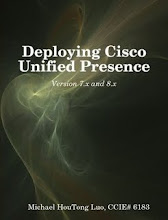GNS3 is actually a front end add-on to DynamIP - which is the real emulator. I'm not going to compare DynamIP and IOU here as this has been done many times. You may search Internet for those articles.
DynamIP and IOU requires quite some command line effort to get them running. Thus some "front end" add-ons were built to make them easier to use. GNS3 is the most popular front end of DynamIP. On IOU side, it's probably IOU Web. These add-ons allow you crate network topologies, save/restore configurations, etc.
From easy-of-use perspective, GNS3 is no doubt a winner. You may drag-and-drop routers/switches in GNS3. However, I prefer IOU because it uses much less resource (CPU/memory) and I'm not afraid of writing up the NETMAP file.
IOU Web doesn't have drag-and-drop. But it has quite a few neat features. For example, you may use any existing network diagram and map the elements on it to any virtual devices. It also has a very powerful configuration/lab management interface.
Things become interesting now when GNS3 can act as IOU front-end.
I tested GNS3 version 1.3 with IOU back end and it works pretty well. I think here's how I would choose between GNS3 and IOU Web:
If I need to create a lab in a very short time (say 20 routers in 15 minutes), I'd use GNS3. Otherwise I'd probably use IOU Web as it gives me more flexibility on documentation and network drawings. Also, as a "minimalist", IOU Web doesn't require any front end software (as it has a http server built-in and uses web interface).
How about Cisco VIRL/CML?
Sigh... when I first heard about the idea two years ago, I was so excited. Finally, an official / vendor-supported network emulator! With the progress lagging on, we're getting more and more frustrated and disappointed.
Yes, Cisco VIRL/CML does have some unique features such as auto-generated configuration, TAC support, etc. But aren't those features more "novice facing"? The most disappointing part was - Cisco didn't (and has no plan) to invest more on the L2 features.
I had a conversation with the CML product manager lately. He admitted that the NX-OS feature on CML was "70% done" because quite a few developers in the Nexus team were laid off. Thus the most interested features such as VDC, VPC are not available on CML. I asked if there's ANY possibility that Cisco continues the development and complete the rest 30% in the future, his answer was a very definite "No". Then I asked him what's the selling point of CML? He just kept repeating "more than 15 nodes" and "TAC supported".
VIRL (personal edition) is selling for $200. CML (enterprise edition)'s price structure is unknown. But price is not the point here. Even if they are free, what's the advantage they have over GNS3 and IOU?



